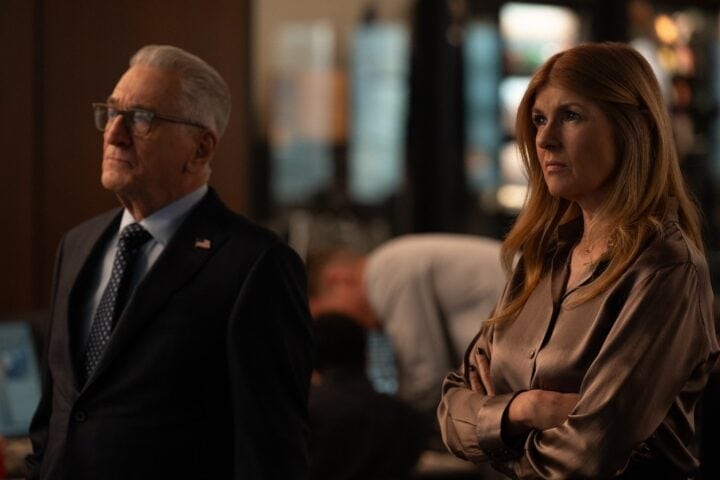Shot while in post-production on Poor Things, Yorgos Lanthimos’s Kinds of Kindness shares with its predecessor a preoccupation with the struggle to achieve autonomy in a bounded world. While the film does mark a return to the austere aesthetics of earlier Lanthimos films like Dogtooth and The Lobster, the more operative change that supersedes and to a degree governs that aesthetic recourse is the swapping out of Tony McNamara, the writer of Poor Things and co-writer of The Favourite, for Efthimis Filippou, who collaborated with Lanthimos on the scripts for The Killing of a Sacred Deer, The Lobster, Alps, and Dogtooth.
Readers familiar with Lanthimos’s work will easily recognize the stark tonal divide between these groups of films. The sadism with which Lanthimos treated his early characters, the cynicism with which he characterized their capacity to change, and the nihilism redolent in his view of the world which encloses them were critical factors in launching his cinema to international notoriety. The McNamara run quickly made it clear that, while these qualities are endemic to Lanthimos’s work, it was Filippou who channeled and greatly intensified them.
The McNamara films domesticated and thereby broadened Lanthimos’s audience appeal, with their migration of violence from the physical realm to the emotional realm, genteel turning of the clock back to a period or period-inspired setting, and shallow investment in the exploration of “women’s agency.” Most noticeable is the reduction in emblems of abjection in his mise-en-scène. Rather than marching his characters toward an inexorable mortification ritual, those films repurpose abjection as but one tool in a broader kit of characterizing devices and greatly diminish its potency. Dogtooth’s tooth smashing and The Lobster’s mutilated animals are ushered behind the lace curtain, replaced by Queen Anne fainting in front of a crowd in The Favourite and Bella Baxter’s polite dalliances with clients as a sex worker in Poor Things.
Lanthimos’s preference for abstraction over context and detail, casual brand of sadism, austere visual style, glib sense of humor, and instrumentalization of actors as tone-setting tools—none of these attributes pose inherent threats to the quality of a film in isolation. Even in thoughtfully arranged combinations they have proven to be compatible and mutually amplifying.
Take The Favourite, whose psychologically acute character detail and use of ribald physical comedy imbue the austere visuals with a kind of ambient satiric quality. The reams of negative space speak to the powerlessness that women experience at each other’s hands but are prevented from articulating by the overt symbols of power that are their opulent surroundings. Just as often, though, these hang-ups snag on each other, rending holes in the fabric of Lanthimos’s films that meaning, insight, and scopophilic pleasure slip into and become lost.
Kinds of Kindness is Lanthimos’s longest film, and the one most hamstrung by his pet interests. It’s comprised of three distinct stories that feature the same handful of actors playing different characters. The first story, “The Death of R.M.F.,” follows the futile rebellion on the part of a businessman, Robert (Jesse Plemons), against his domineering boss, Raymond (Willem Dafoe), and eventual tailspin into madness and murder. The second, “R.M.F. Is Flying,” follows a man, Daniel (Plemons), struggling to accept that his wife, Liz (Emma Stone), having finally returned after being lost at sea, is actually his wife. He, too, tailspins into madness and violence. And the final story, “R.M.F. Eats a Sandwich,” centers on Stone’s Emily, who’s left her child and husband, Joseph (Joe Alwyn), to search for a Lazarus figure (Margaret Qualley) on behalf of a cult led by an enigmatic couple (Dafoe and Hong Chau). The only character to appear in all three stories is the silent R.M.F. (Yorgos Stefanakos), though he’s never quite the same in each.
Despite the section breaks and three rounds of credits constantly reminding you of Lanthimos’s hand guiding the procession, you don’t feel the filmmaker white knuckling the controls behind the screen here like you often do. The result is counter to what you might expect: Because his inclination is toward suppression, smothering banality, and cerebral detachment, his lack of focus on this film renders a more crudely over-determined and unyielding product than he’s made in some years. The abstraction is presented with even more cloying cuteness, the sadism is more juvenile and purposeless, and the humor is stomach-turningly glib.
The film is particularly aggressive in its non-specificity. The point of “The Death of R.M.F.” is that Raymond (Dafoe) has given Robert (Plemons) his life, but in his dictatorial control, renders it unlivable. Plemons does his best Coens-style handwringing, temple-sweating, put-upon everyman, but the segment doesn’t bother to share any meaningful details about the life being petitioned for. The job that yokes them together remains unspecified; Robert’s house is a white womb of museum-like artifacts; there’s no joy in his relationship with his wife, Sarah (Chau); and he has no discernible personality outside of his consuming relationship with Raymond. These details sound like examples of the effect Raymond’s control has had on Robert’s life, but it’s really just a matter of course. The same under-characterization marks each story.
Liz (Stone) is apparently so committed to her job that she went down with a ship (somewhere, it’s never specified) while doing it in “R.M.F. Is Flying.” She’s so good at that job that in one scene she receives an award at a gala, but we never learn what she actually does. Her husband Daniel (Plemons) is a police officer but not for any particular city. The cars and department HQ bear the cryptic logo “DPSD Police Department.” We never learn what the cult that Emily (Stone) joins in “R.M.F. Eats a Sandwich” is really after, which makes her leaving her husband and child for them—the critical stakes of the entire story—a question not worth asking. The one line that Stone is given to her estranged husband, Joseph (Alwyn), to indicate their past intimacy is “How’s everything at the office? Did you get that promotion?”
What office? What job? Lanthimos and Filippou don’t care. The time-worn details of a lived-in space, the specifics of a daily routine, the unique rhythms of love and friendship—these things have profound impacts on people’s psyches and emotional systems, greatly influencing how they conduct their lives, treat others, and react to certain stimuli. But Lanthimos and Filippou are so interested in watching what happens to people when you place them in a tough situation and crank up the pressure that the very processes by which people develop their pressure responses falls by the wayside. Every character in Kinds of Kindness is a stock one. The fact that they find themselves in unique situations and have unique reactions to them is meaningless.
Further, the ascetic visual scheme, conversion of actors into instruments of tone, and constant emptying of dramatic potential with smug jokes flatten the film’s affective dimensions and conscript the characters to such a degree that allegorical readings aren’t even possible. Lanthimos and cinematographer Robbie Ryan cut to abstract shots of characters’ hands and legs while they’re speaking, and frequently bracket their bodies in wide and medium wide shots, isolating them in oppressive negative space. It could have emphasized the contrasting nature of their predicaments, both overwhelming and hollow. But other elements arrest the potential for such complexity. The dialogue is written in a stilted tone that veers toward the clinical (the word “mustn’t” is used in casual conversation at least four times) and directed to be delivered flat. This regime of monotony subsumes almost every actor, with only Dafoe and Chau managing to wriggle out and enliven their characters with a bit of mystery.
The film would be dull if it merely asked us to care what happens to characters that it goes out of its way to disinvest from. But its senseless and, ultimately, cowardly fascination with violence makes it an actively hard watch. In “R.M.F. is Flying,” Daniel shoots Jerry (Alwyn) in the hand and licks his blood, and later directs his wife to cut off her finger to see if it’s really her. In “The Death of R.M.F.,” Robert runs R.M.F. over twice with his car, killing him. Each of these scenes is staged, shot, and edited to be as direct as possible, employing undecorated framing and minimal cuts. Violence generally serves a purely narrative function in Lanthimos’s films, pushing characters past the point of redemption and into his sights so he can deliver the kill shot.
The central act of violence in “R.M.F. Eats a Sandwich” is different. The story’s protagonist is the victim of violence rather than its perpetrator, and the aesthetic scheme used to depict her victimization follows suit, shifting from direct to indirect. After relenting to Joseph’s advances (and her own stifled desire) to re-establish contact, Emily is drugged and raped by her estranged husband. Rather than shoot the scene head-on without cuts or frills, Lanthimos opts for the abstract approach—a delicate, disembodied shot of Stone’s feet being thrusted back and forth. Then, the subsequent scene shows Emily being ejected from the cult after a sweat test deems her impure. The bottom line thuddingly asserts itself, and it’s grim: Corrupting violence is needed to advance the plot. Whether it’s the violence men do or the violence done to women is no matter, so long as Lanthimos and Filippou render a punchline for one final, nasty joke.
The shift in aesthetic approach to the scene, though, gives up the game. The indirect framing of Kinds of Kindness’s rape scene suggests that Lanthimos had at least an inkling that something about sexual violence is different enough from battery and homicide to warrant a change, but not enough to elevate it beyond its use as a crude means of delivering the story’s final blow.
Rape is an act of violence defined by oppositions: appallingly intimate yet so brutal that its survivors share symptomology with the survivors of mass atrocities; physical in nature but its psychic afterlife is endless; it kills you, even when you don’t die. Lanthimos, though, refuses to engage with rape’s inalienable complexity, because to engage with any complexity would demand depth from a filmmaker whose preoccupations have anchored him to the shallows. So he simply pans away from the unpleasantness. Kinds of Kindness contains the seeds for several good movies, but Lanthimos doesn’t have the patience to cultivate them.
Since 2001, we've brought you uncompromising, candid takes on the world of film, music, television, video games, theater, and more. Independently owned and operated publications like Slant have been hit hard in recent years, but we’re committed to keeping our content free and accessible—meaning no paywalls or fees.
If you like what we do, please consider subscribing to our Patreon or making a donation.





Can a character’s limbs be considered a metonymic representation of the character? Couldn’t all humans be be represented in the same way, rendering the specificity of metonymy redundant? Does Ryan just like the word metonymy?